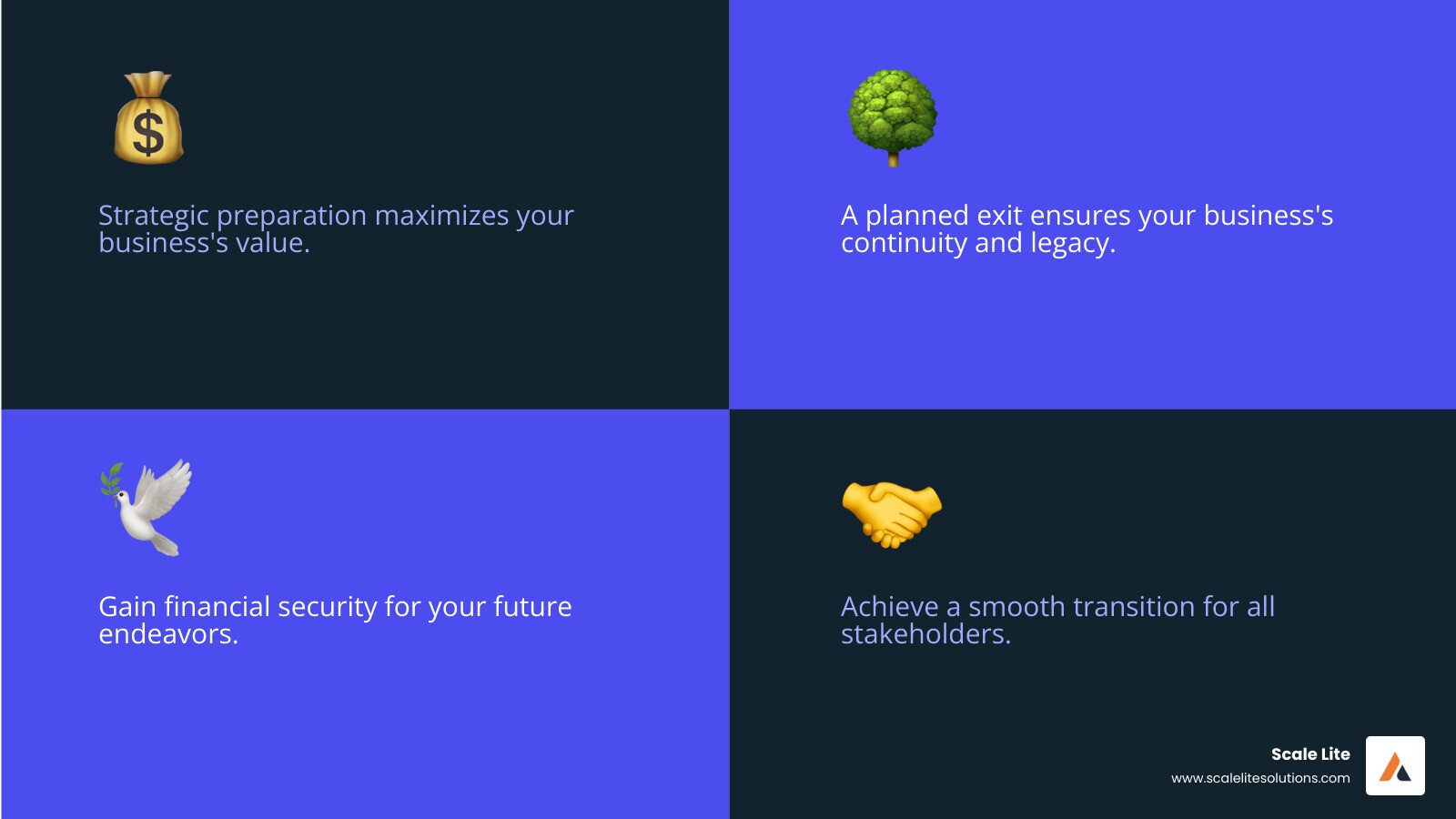
Ready, Set, Exit—Top Business Exit Strategies Explained

Why Every Business Owner Needs an Exit Strategy
An exit strategy in business is a strategic plan for how an owner will eventually leave their company, whether through a sale, ownership transfer, or by winding down operations. Here are the key types:
Common Exit Strategies:
- Merger & Acquisition (M&A) - Selling to another company
- Management/Employee Buyout - Transferring to internal team
- Family Succession - Passing to next generation
- Initial Public Offering (IPO) - Going public
- Selling to Partners - Transferring to existing stakeholders
- Liquidation - Closing and selling assets
- Bankruptcy - Legal process for insolvent businesses
The numbers tell a compelling story. Over three-quarters of small business owners plan to exit by 2033, with trillions in assets changing hands. A large portion of these owners are nearing retirement age. Yet, despite this, about 53% of entrepreneurs lack an exit strategy, according to William Buck’s 2019 Exit Smart Survey Report. This planning gap creates a huge opportunity cost. For example, one owner who spent seven years preparing his business for sale—building a management team and upgrading systems—achieved a sale price of over $100 million. In contrast, another owner, overwhelmed by stress, simply gave his business away, likely forfeiting millions.
Why having an exit strategy matters:
- Maximizes business value through strategic preparation
- Provides financial security for retirement or new ventures
- Ensures business continuity for employees and customers
- Creates leverage in negotiations and decision-making
I'm Keaton Kay, founder of Scale Lite, and I've spent years in private equity evaluating what makes businesses valuable. Our experience shows that the most profitable exit strategy in business scenarios happen when owners start planning years, not months, in advance.

Easy exit strategy in business word list:
7 Common Business Exit Strategies (and Their Pros & Cons)
Choosing an exit strategy in business depends on your personal goals, financial needs, and vision for your company's future. Let's walk through the seven most common paths.
1. Merger & Acquisition (M&A)
The M&A route involves selling your company to another business, either a strategic buyer from your industry or a financial buyer like a private equity firm. The main appeal is the potential for a premium price and a clean break post-sale. However, M&A deals are complex. The due diligence process is lengthy, and as Ansarada Deals™ notes, often "time-consuming and costly, and deals often fail." You also lose complete control and face confidentiality risks during the process.
2. Management or Employee Buyout (MBO/ESOP)
In a management buyout (MBO), your leadership team purchases the company. An Employee Stock Ownership Plan or ESOP extends ownership to employees. This path is ideal for preserving company culture and rewarding a loyal team, ensuring continuity for employees and customers. The trade-off is a likely lower sale price, as internal buyers have less capital. You may also need to provide seller financing, receiving payments over time instead of a lump sum.
3. Family Succession
Passing the business to family is a natural choice for continuing a legacy. Benefits include potential tax advantages and the stability of family continuity, which employees and customers often appreciate. However, complex family dynamics are a major hurdle. As Amy Wirtz, a Senior Consultant with The Family Business Consulting Group, notes, you must ensure the business can financially support the new owners. With only 34% of family businesses having a documented succession plan according to PwC, the risk of internal conflict is high.
4. Initial Public Offering (IPO)
An IPO offers access to public capital, high valuation potential, and prestige. But IPOs are rare, generally only for businesses valued over $100 million. The downsides are staggering costs (often over $1 million), strict ongoing compliance requirements, intense public scrutiny, and a loss of privacy and control as you become accountable to shareholders.
5. Selling to a Partner or Investor
Selling your stake to an existing partner or investor is often a simpler and faster exit path. Because they already know the business, due diligence is less extensive, leading to quicker negotiations and minimal business disruption. Downsides include potential valuation disputes and partners lacking capital, which may require seller financing. Strong shareholder agreements are crucial to prevent damaging personal relationships.
6. Liquidation (Closing the Business)
Liquidation means winding down operations and selling assets to pay debts. This route offers simplicity and can be lucrative if the business owns valuable assets, like prime real estate, that are worth more than the ongoing operations. The major drawback is that intangible value (brand, customer lists) is lost. Also, large asset sales can trigger significant tax consequences. The process involves filing dissolution documents, canceling licenses, and paying all final employee wages before closing your business.
7. Bankruptcy
Bankruptcy is a legal process for businesses that cannot pay their debts, allowing for reorganization or court-supervised liquidation. The main benefit is debt relief and protection from creditors, offering a fresh start. However, the consequences are severe: damage to your credit and reputation, loss of control to a trustee, and public record of the proceedings, making it the least desirable option.
Each of these exit strategy in business options serves different goals. The key is understanding which path aligns with your vision, ideally years before you need to use it.
How to Choose and Plan Your Exit Strategy in Business
Choosing the right exit strategy in business requires careful thought about your goals and circumstances. With proper planning, you can design an exit that fits your needs perfectly.

Developing a comprehensive Business Exit Plan is like creating a roadmap for one of the most important journeys of your business life.
Factors to Consider When Choosing Your Exit
- Your personal goals are the foundation. Do you want to retire, launch a new venture, or stay involved as a mentor? Your vision for the future will shape your strategy. As Andrew Van Alstyne, Financial Planner at Fiduciary Financial Advisors, states, "Many owners are deeply interwoven with their business from a financial perspective... The best way to work through this is by having a plan in place."
- Your financial needs versus wants is about defining what financial freedom means to you. Determine the amount you actually need to live the life you want post-exit.
- Your desired level of future involvement shapes your options. A clean break might point to an M&A, while a desire to stay involved could favor a management buyout with a consulting role.
- Business health and readiness are critical. A profitable, growing business with strong systems and a capable management team will attract buyers and command a premium. A business that relies entirely on you is a much harder sell.
- Current market and economic conditions affect timing and valuation. High interest rates, for example, make debt financing expensive, which can lower what buyers are willing to pay.
The 5 Key Steps to Develop Your Exit Plan
Creating an exit strategy in business follows a logical sequence.
Step 1: Define Your Personal and Financial Goals. This comes first because it determines how much you need from the sale and what you want your life to look like afterward.
Step 2: Determine Your Business's Value. Understanding what your business is worth today provides a baseline. This includes tangible assets as well as intangible value like customer relationships, brand, and growth potential.
Step 3: Prepare the Business for Sale. This involves cleaning up financials, optimizing operations, building a strong management team, and documenting processes to show buyers the business can thrive without you.
Step 4: Assemble Your Exit Team. A complex business exit requires a team of experts, including lawyers for legal structuring, accountants for tax strategy, business brokers to find buyers, and financial advisors to manage your wealth post-sale.
Step 5: Create and Execute the Transition Plan. This is your detailed roadmap for the handover, outlining roles, timelines, and communication with stakeholders to ensure a smooth transition.
The Critical Role of Business Valuation
Business valuation is the heartbeat of your exit strategy in business.
- Setting a realistic price is crucial. Pricing too low leaves money on the table; pricing too high scares away serious buyers.
- Having a solid basis for negotiation means bringing professional analysis to the table, not just an opinion.
- Identifying value drivers and weaknesses is a key outcome of valuation. It might reveal issues like customer concentration or highlight valuable intellectual property.
Professional appraisers use different valuation methods, such as asset-based, cash-flow analysis, or market comparisons. The importance of professional appraisers cannot be overstated. Organizations like the National Association of Certified Valuators and Analysts certify experts who can provide a fair value that holds up under scrutiny. Valuation isn't a one-time event; it should be revisited as your business and the market evolve.
Preparing Your Business for a High-Value Exit
Preparing your business for an exit is like getting a house ready to sell. The more polished and organized it is, the more attractive it becomes to buyers. The difference between a premium price and a business that languishes on the market often comes down to preparation.

Strengthening Financials and Operations
Clean and accurate financial records are your foundation. Messy books are a major red flag for buyers. As research from Harvard Business Review shows, companies with standardized financial practices achieve higher valuations.
Consistent profitability demonstrates that your success is a repeatable pattern a buyer can count on, not a fluke.
Reducing owner dependency is crucial for any successful exit strategy in business. If the business can't run without you, you've built a job, not a sellable asset.
Documented Standard Operating Procedures (SOPs) are your secret weapon. When every process is documented, you create a blueprint a new owner can follow, making your business repeatable, scalable, and far more attractive.
Enhancing Value Through Technology and Automation
For blue-collar service businesses, modernizing operations is a golden opportunity to stand out.
Implementing a CRM system organizes client information in one place, showing buyers you have a systematic approach to managing customer relationships.
Automating workflows like scheduling, dispatch, and invoicing saves time, reduces errors, and proves your business can scale efficiently. This forward-thinking approach excites buyers.
Using data to drive decisions separates professional operations from those run on gut feelings. Showing buyers hard metrics on customer acquisition costs and profit margins demonstrates predictability.
Improving scalability through technology answers a buyer's biggest question: "Can this business grow?" Our approach to Business Value Improvement focuses on these exact improvements. For service companies, technology makes you more attractive to buyers by reducing their risk. Our experience in How to Sell a Service Business proves this repeatedly.
Ensuring a Smooth Transition for Stakeholders
An exit announcement affects everyone, from employees to customers. A well-managed transition is critical to preserving business value.
Developing a communication plan is essential. As Dr. Michael Barbera, Chief Behavioral Officer at Clicksuasion Labs, explains, "To prevent unnecessary concern, business owners should focus on maintaining consistency in practices, policies, and communication."
Retaining key employees is vital, as they represent valuable institutional knowledge. Consider stay agreements or transition bonuses to ensure your best people remain through the handover.
Maintaining customer confidence requires proactive communication. Inform customers about the transition and how it will benefit them, and introduce new leadership early when possible.
Managing uncertainty is key. As Mark Valentino, Head of Business Banking at Citizens, notes, owners must consider the cultural fit of successors and use "meaningful, careful communication" to avoid misalignment with the company's mission.
Frequently Asked Questions about an Exit Strategy in Business
Planning your departure from a business you've poured your heart into can be daunting. Here are answers to the questions we hear most often.
When should I start planning my exit strategy?
Ideally, you should start planning your exit strategy in business the day you start your business. An exit strategy isn't just about leaving; it's a framework that should shape major decisions along the way, from legal structure to team building.
Preparing for a high-value exit is a long-term process, typically taking 3 to 10 years. It's about building a business that's truly worth buying by creating systems that work without you, developing a strong management team, and establishing consistent profitability. Starting early gives you time to address weaknesses, build value systematically, and make strategic decisions that serve both current operations and future exit goals.
What are the biggest pitfalls to avoid in an exit strategy in business?
Most pitfalls are avoidable if you know what to watch for.
- Procrastination: Waiting until you're burned out or facing market pressures puts you in a weak negotiating position. This is why about 53% of owners have no plan.
- Unrealistic valuation expectations: Emotional attachment can cloud judgment. Buyers care about consistent, repeatable results, not the sweat equity you've poured in. Get a professional valuation to stay grounded.
- Poor financial records: Messy books scream "risk" to buyers. Clean up your accounting years before you plan to sell.
- Neglecting tax implications: Different exit strategies have vastly different tax consequences. Work with a tax professional early to understand what you'll actually net from a sale.
- Failing to communicate with stakeholders: Surprising employees, customers, or suppliers with a sudden exit can create chaos that hurts business value.
- Making emotional decisions: Your business may feel like your baby, but to a buyer, it's an investment. Try to separate your emotions from the transaction.
How do I tell my employees and customers I'm exiting?
This requires a clear, thoughtful communication plan that prioritizes stakeholder concerns.
Start with empathy and transparency. Your employees will worry about their jobs, and customers will question service quality. Address these concerns head-on with honest communication.
Timing is critical. Don't announce plans too early, but waiting until the last minute creates unnecessary anxiety. Give people enough time to adjust.
Focus on reassurance about the future. Highlight what will stay the same, such as company values and commitment to service. Frame the change as an opportunity for growth where possible.
Introduce new leadership early when appropriate. This helps build trust and confidence in the transition by allowing stakeholders to meet the new owner and understand their vision.
A well-managed communication process can strengthen relationships and preserve business value. People appreciate honesty and will often be supportive when they feel confident about the company's future.
Conclusion
Your exit strategy in business isn't just an ending—it's the culmination of everything you've built. The value you capture depends entirely on the preparation you do today.
With a historic transfer of business assets on the horizon as owners plan to exit, the gap between those who plan and those who don't can mean the difference between a life-changing payday and leaving money on the table.
For service-based businesses and companies in low-tech industries, modernization is essential for a high-value exit. We've seen it repeatedly: an HVAC company doubles its valuation with automated scheduling, or a landscaping business becomes irresistible to buyers by adding GPS tracking and customer portals. These data-driven operations sell for a premium because buyers can see a clear path to scale.
The right technology and automation don't just prepare you for exit—they improve your business while you're still running it, leading to less stress, more efficiency, and better customer service.
At Scale Lite Solutions, we help business owners bridge this gap. We understand that "going digital" can feel overwhelming, so we implement a holistic mix of technology, automation, and systems custom to your industry and goals.
Your exit strategy in business should be a celebration of your accomplishments, not a fire sale. The businesses that command the highest prices are those that run smoothly, grow predictably, and don't depend on their owner's daily involvement.
Ready to start preparing for your ideal exit? Learn how to become a hands-off business owner and prepare for your exit. The best time to plan your exit was yesterday—the second best time is today.






